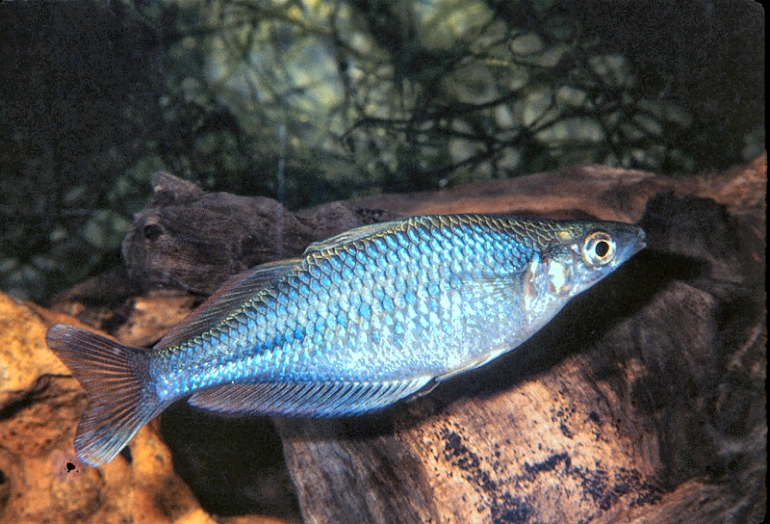|
 |
Chilatherina campsi - photo© Neil Armstrong |
(Whitley, 1956)
Highland Rainbowfish
Species Summary
During July 1954, Ellis Le Geyt Troughton and Norman Camps, from the Australian Museum, visited New Guinea and collected a number of freshwater fishes. Among the fish collected was an undescribed rainbowfish species. Gilbert P. Whitley, an ichthyologist at the Australian Museum, described them as Anisocentrus campsi in 1956 after one of the collectors, Norman Camps. They were subsequently reassigned to the Chilatherina genus where they remain today.
Chilatherina campsi have a body colour of pale bluish-white with a silvery sheen; pale yellow to whitish longitudinal stripes frequently bordering scale rows and a broad blue mid-lateral stripe (most prominent on posterior part of body); fins white, sometimes with yellow suffusion; maximum size around 8-9 cm SL. Males are deeper bodied than females and their overall pattern is more intense, particularly the mid-lateral stripe. In addition the vertical fins of females are mainly translucent in contrast to the whitish fins of males. There were two different colour varieties available in the aquarium hobby, one with red fins, and one with blue fins. However, the origin of these different varieties is not known to me.
Distribution & Habitat
Chilatherina campsi occurs in the central highlands of Papua New Guinea, hence its common name 'Highland Rainbowfish'. The genus Chilatherina is usually only found in the northern areas of New Guinea but C. campsi have been found in southern stream habitats. It is the only member of the genus thus far found on both sides of the Central Dividing Range, which has acted as a most effective geographical barrier to the spread of most rainbowfish species northerly or southerly. This species was first collected in 1954 from a tributary of the Jimmi River, situated approximately 420 km from the mouth of the Sepik River via the Yuat River. They have been collected from dispersed localities in the Markham (Oomsis Creek, Wampit River), Ramu, Sepik, and Purari (Lima River) river systems. Most collection sites have been in the northern drainage division, but they have also been collected from the Wahgi and Pima Rivers, both highland tributaries of the Purari River that flows southwards into the Gulf of Papua, and from the Oomsis River near Lae.
Within their distribution range C. campsi are generally found in mountainous or foothill streams. They are most abundant in the smaller flowing tributaries, shallow bodies of water shaded by rainforest trees where they find shelter among aquatic plants, roots, and fallen branches. Although situated in rainforest habitat the streams are relatively open and exposed to sunlight, which is typical of the type of habitat where Chilatherina normally occurs. Depending on the precise location, the water is generally soft, slightly turbid with a temperature range of 21-26° Celsius and pH 7.6-7.8. Other rainbowfishes found co-habiting with Chilatherina campsi include Melanotaenia affinis, Melanotaenia pimaensis, and Glossolepis maculosus.
Remarks
The first live specimens to enter the aquarium hobby were collected by Gerald Allen and Brian Parkinson from the Wahgi River (Purari River system) near Mt Hagan in 1979. Then in the early 1980's, additional specimens was collected by Barry Crockford from the Oomsis River near Lae and a small stream on the Highland Highway 105 km northwest of Lae, both foothill tributaries of the Markham River. Heiko Bleher collected live specimens from a tributary of the middle Ramu River in 1988. These collections formed the founding stock of current aquarium populations. Although, there have been some more recent undocumented aquarium collections. Nonetheless, C. campsi have never been widely available and only a handful of enthusiasts are still maintaining them today.
Literature
Allen G.R. (1981) A Revision of the Rainbowfish Genus Chilatherina (Melanotaeniidae). Records of the Western Australian Museum 9(3): 279-299.
Whitley G.P. (1957) Fishes from inland New Guinea. Records of the Australian Museum 24(3): 23-30.
Adrian R. Tappin
Updated August, 2015



|
|

